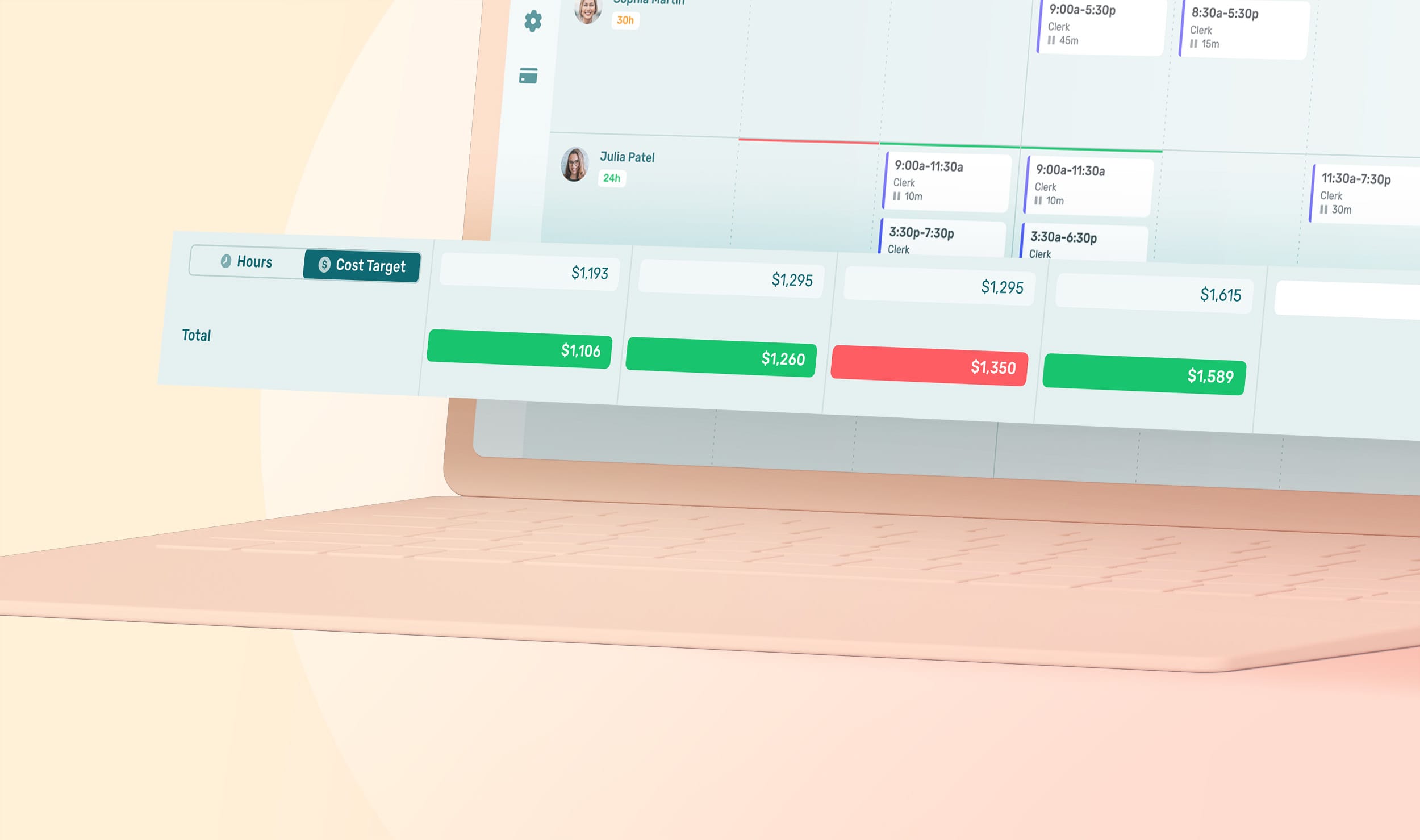Scheduling Shifts: What Is It & How to Master the Shift Scheduling Process
Shift work scheduling is a method of scheduling employees to work in rotation. Employees work specific hours on specific days.
Shift schedules are commonly used by businesses that operate 24/7. Different types of work shifts exist: fixed shifts, split shifts, rotating shifts, weekend shifts, on-call shifts, etc.
Learn the main steps in creating and managing an employee work schedule that will optimize business performance and employee satisfaction. See how shift scheduling tools can eliminate the frustration and guesswork of creating and managing employee shift schedules manually.
What Is a Shift Work Schedule?
A shift work schedule is a method of scheduling employees based on rotating work shifts. Shift scheduling is commonly used by businesses with 24/7 operations. Often, employees work specific hours on specific days, although schedules may vary depending on the type of shift schedule used by the business: fixed, split, rotating, weekend, on-call, etc.
Benefits of Scheduling Shifts for Your Employees
Businesses that schedule employees efficiently outperform competitors in a number of areas:
1. Lower Employee Turnover
Employees who are happy with their work schedules are less likely to seek employment elsewhere.
It’s important to schedule employee shifts that are fair and accurate—and published well in advance so that changes and shift swaps can be made if needed.
This will help improve the employee experience and overall job satisfaction of shift workers.
Better employee retention is not the only benefit.
- Offering employees their preferred stable or flexible work shift can also help your business attract quality talent—a major bonus during the ongoing labor shortage.
- Ensuring full roster coverage keeps workloads and stress levels manageable for hourly workers, which improves operational efficiency.
2. Easier Time-Tracking and Payroll
All businesses that need to manage employee shift schedules also need to manage time tracking.
This is more than simply tracking employee attendance. It may also include:
- Tracking time employees take for breaks and lunch hours
- Tracking late-shows & no-shows
- Tracking employee overtime status, including mandatory overtime
Creating an accurate work shift schedule—whether weekly, bi-weekly or monthly—is the first step in employee time tracking.
In turn, proper time tracking is needed to submit accurate payroll data. And as any manager knows, nothing is more demotivating to hourly wage employees than not being paid all hours worked.
Administrative tasks like employee scheduling, time tracking and payroll preparation can quickly eat into a manager’s week, monopolizing precious time that could be spent on building value for the business—such as improving employee onboarding and training.
3. Better Employee Productivity
The best employee schedules align employee skills with the work that needs to be done. By making sure you have the right mix of skills scheduled for each shift, each employee can focus on what they do best.
This can lead to a powerful synergy that significantly improves employee productivity and satisfaction.
4. Smoother Business Operations
Another benefit of scheduling the right employees for the right shift? Smoother business operations.
For example, it makes sense to schedule your best employees to work your busiest hours, and let new employees learn the ropes during slower shifts.
You can also pair experienced and highly engaged employees with new hires to impart the company culture and improve the employee experience during the crucial onboarding stage.
5. Lower Labor Costs
Creating an employee schedule that optimizes work shifts can also reduce labor costs.
Lower labor costs for every workplace you manage: See how Agendrix’s employee scheduling software streamlines your management operations by centralizing employee schedules and timesheets under one convenient app.
Most Common Types of Shift Work Schedules
Any business that needs to ensure specific work is done at specific times needs to create and manage shift work schedules efficiently.
The only exceptions are very small businesses with just a handful of employees.
Here are the most common types of shift work scheduling used to manage workforce operations.
1. Fixed Shift Schedule
With a fixed shift schedule, employees work the same days and hours each week.
For businesses that operate during “normal business hours,” this might mean scheduling all employees to work Monday to Friday, from 9 am to 5 pm.
Employees that work fixed shifts include:
- Bank tellers
- Sales representatives
- Dental hygienists
Companies that operate extended hours may have multiple fixed shifts each day.
- A fitness center that’s open from 6 am to 10 pm may need to schedule two shifts a day: a first shift (6 am to 2 pm) and a second shift (from 2 pm to 10 pm).
- A 24/7 company like Amazon might choose to schedule employees over three shifts each day: a morning shift (8 am to 4 pm), an evening shift (4 pm to 12 am) and an overnight shift (12 am to 8 am).
2. Rotating Shift
Rotating shifts change over time—from week to week or from month to month.
Rotating shifts are common in the retail and restaurant industries, where employee availability and business needs can fluctuate.
For example:
A customer service rep might work six weeks of day shifts, followed by six weeks of night shifts.
A first responder might work:
- 7 am to 3 pm on Monday
- 3 pm to 11 pm on Tuesday
- 11 pm to 7 am on Wednesday
- Off on Thursday and Friday
- 7 am to 3 pm on Saturday
3. Split Shift
Employees who work split shifts work more than one shift a day. Often, the workday is broken up into two half-shifts.
For example, serving staff at a happy hour cocktail bar that serves light lunches might work the lunch rush from 10:30 am to 1:30 pm, take a few hours off and then come back to work the after-work happy hour shift from 4 pm to 9 pm.
4. On-Call Shift
Employees who work on-call (or on stand-by) have unpredictable shifts. In some instances, employees are expected to call in an hour or two before their shift starts to see if they are actually needed for work or not.
In other instances, on-call employees don’t have to call ahead of time, but they must be available to work at any time during the shift if their employer calls them in (often with short notice).
Sometimes the employer can limit where the employee can go when on-call but not at work.
In many instances, employers need to provide on-call pay. The laws surrounding on-call pay can be a little murky. Under the Fair Labor Standards Act, on-call hours may or may not be considered hours worked.
5. Weekend Shift
Employees who work weekend shifts typically work Friday nights, Saturdays, and/or Sundays. Weekend shifts are typically used in conjunction with a fixed or rotating shift system.
A weekend shift can be a great way for businesses to hire part-time employees such as students who are busy with school during the week.
Weekend shifts are common in industries like:
There are still other types of rotating shift schedules that may work better for your business.
Employee Scheduling Issues to Steer Clear From
1. Not Having Enough Staff
All businesses need a minimum number of employees to maintain an acceptable level of customer service.
Only hiring the bare minimum can leave you in hot water if an employee suddenly has to leave work for an emergency or calls in sick—or if customer traffic unexpectedly skyrockets.
Suddenly finding yourself short-staffed can lead to:
- Extra stress on existing staff, causing employee morale and productivity to plummet
- Unacceptable wait times for customers, leading to lost sales and business reputation
- Greater risk of employees quitting en masse
2. Overscheduling Employees
Being short staffed can quickly lead to another common shift scheduling mistake: overscheduling.
In other words, making employees work more hours than they want—or can handle.
While some hourly workers may appreciate picking up a few overtime hours every now and again, requiring team members to work extended hours for extended periods of time will eventually destroy the work-life balance we all need.
Overscheduled employees are associated with:
- More workplace accidents
- Poor work performance
- Low job satisfaction
- Low employee engagement
- Higher rates of absenteeism
- Poor customer feedback
- Burnout
- Higher employee turnover
One sure sign that you’re overworking employees is the work schedule regularly has employees working the “clopen” slot.
3. Unfair Scheduling
Every team has its “star players” and many businesses have one or two employees who particularly excel at certain tasks.
While it’s only normal for employers to want to make best use of their human resources, playing favorites could expose your business to risk—in the form of penalty charges or grounds of discrimination.
Unfair scheduling can mean a lot of things:
- Not giving an employee the required time off
- Refusing to accept time off requests submitted by an employee
- Failing to give advance notice of shift changes (typically 7 to 14 days)
- Not staying on top of changes to employee scheduling laws
4. Not Having a Formal Employee Schedule
Businesses that care about their employee happiness strive to give them sufficient advance notice of their work schedules.
At the same time, businesses need to build enough flexibility into their scheduling practices so that employees can request a shift swap if something suddenly comes up.
It may also happen that you need to schedule an employee to cover a shift last minute.
Creating a shift schedule that’s both structured yet flexible isn’t easy with manual processes. It becomes even more difficult as the number of employees, teams, shifts and job sites climbs.
This is why the vast majority of businesses focused on efficiency, best practices and compliance with labor laws use employee scheduling software or free work schedule templates.
5. Assuming Employee Availability
All employees need to take time off now and again—whether it’s planned or unplanned time off. Various reasons may be behind time off requests:
- Illness
- Personal emergency
- Vacation time
- Family obligation
- Mental health day
On top of these reasons, there are specific days and shifts that many employees would prefer to work over others.
Neglecting to ask employees to fill out an employee availability form is a sure way to create inaccurate schedules that will most likely need to be changed.
This also means you’ll need an efficient way to communicate schedule changes to your team.
Failing to take employee shift preferences and availability into account can lead to scheduling chaos. Especially if you don’t have a good backup plan to handle the inevitable employee absenteeism and no-shows.
6. Prohibiting Shift Swapping
Shift swapping lets employees exchange work shifts with each other so that they can attend to other obligations when needed. Swapping shifts is a common practice in the retail and restaurant industries.
Allowing employees to swap shifts gives them a better work-life balance while still ensuring that business needs are being met.
Prohibiting shift swaps can negatively impact the employee experience and impact employee engagement.
4 Tips for Effective Shift Scheduling
Use the following shift scheduling best practices to identify the type of shift schedule that’s best for your business. These scheduling tips will also help you create more accurate employee schedules with less time and effort.
1. Analyze Your Business Needs and Workforce
- How many employees do you have on staff?
- What type and what volume of work needs to be done each shift?
- What skill sets do you need for each shift?
- What are the busy periods that require more employees to ensure proper coverage?
- What employee or business constraints do you have to respect? Do you have to closely manage labor costs or overtime limits?
If needed, use observational or historical data to answer these questions. Then use these insights to determine which shift schedule is best for your team.
Track labor costs directly in your shift schedule.

Agendrix employee scheduling software lets managers easily view staffing costs in real time and adjust staffing levels at any hour of the day.
2. Have Employees Fill Out an Employee Availability Form
Ask all employees to fill out an employee availability form. These forms document the availability of each staff member by shift and day of the week.
These are typically simple forms that are easy for employees to fill out and for team leaders and shift supervisors to use during scheduling. They’re also a great time-saving way to create more accurate schedules and minimize scheduling conflicts.
Download our free employee availability form
Asking employees for their scheduling preferences also makes them feel valued. Even collecting minimal employee input can help boost team morale and improve retention.
3. Assign Shifts
Use your chosen shift schedule, the completed employee availability forms, and scheduling rules to assign employees to shifts.
Using an employee shift scheduling software like Agendrix will make this task infinitely easier. You can easily create a shift template and reuse or modify it as needed for each scheduling cycle and for each work site you manage.
Eliminate Employee Scheduling Headaches
Employee shift scheduling software immediately flags any scheduling conflicts based on your defined constraints and employee availability. It also lets you communicate schedules to employees, make changes, track employee hours and submit information for payroll.
See how Agendrix software makes employee shift scheduling easy from start to finish.
4. Regularly Improve Scheduling Practices
Review your employee scheduling process on a regular basis to ensure it is meeting the needs of both your business and your employees. Be sure to analyze its effectiveness for slow, normal and busy periods.
Analyze business metrics for:
- Sales & returns
- Customer satisfaction
- Employee absenteeism, late-shows or no-shows
- Employee satisfaction
- Employee retention
If these metrics aren’t where you want them to be, you may have to improve your employee scheduling practices and overall shift management.
Agendrix is all-in-one scheduling and HR management software that helps you create a great employee experience to keep staff engaged and productive.
How to Take Shift Scheduling to the Next Level?
You can take employee scheduling to the next level by integrating employee engagement surveys.
Collecting and measuring employee feedback will provide important insights about your organization’s day-to-day operations.
- See what’s working well
- Identify issues as they emerge to maintain a good employee experience
- Take action quickly to improve employee satisfaction
- Communicate initiatives to increase employee engagement
- Measure metrics over time to ensure you’re on the right track
Easily create great employee surveys right from Agendrix employee scheduling software.
A Positive Example of Scheduling Work Shifts
What to see how all of this comes together in practice? Check out our YouTube video:
Conclusion
Creating an employee shift schedule doesn’t have to be difficult or time consuming.
With the right tools, you can easily create accurate shift schedules in no time—while simultaneously improving job satisfaction and productivity for both front line workers and managers. Higher customer service levels and sales are sure to follow.
Manage workforce operations and scheduling, keep track of staff time & attendance, and improve communications—all from one incredibly easy to use tool.
If you’d like to learn more about creating a 24-hour shift schedule for your business, check out our guide: How to Create a 24-Hour Shift Schedule for Your Business + Tips.
How Do You Schedule Employee Shifts?
There are 4 main steps in creating a great employee shift schedule.
- Analyze your business needs and workforce to determine which type of shift schedule will help you best achieve your business goals.
- Have employees fill out an employee availability form to know which shifts and days they are available to work.
- Assign shifts. Use the selected shift schedule and your defined scheduling constraints to ensure all shifts are covered without any conflicts.
- Regularly improve scheduling practices to ensure your employee scheduling is supporting rather than hindering overall business performance.
Adopt employee scheduling best practices with Agendrix employee scheduling software.
How Do You Manage Your Shift Schedule?
Shift work schedules can be managed:
- Manually on paper
- Using an Excel schedule template
- Using fit-for-purpose shift scheduling software
What Is the Goal of Shift Scheduling?
Shift scheduling lets round-the-clock businesses and mission critical industries rotate employees to maintain continuous operations.
Many industries use shift work schedules to organize resources:
- Hospitality
- Manufacturing
- Restaurants and bars
- Retail
- Healthcare
- Public service
What Is the Best Shift Schedule?
There is no one “best” shift work schedule. It depends on a host of factors, such as your industry, your business, and the number of employees that are required for each shift.
For example, in the healthcare industry, rotating shifts are often used. A typical work schedule of a healthcare worker might look like this:
- Three 12-hour days shifts
- Two days off
- Three 12-hour night shifts
- Two days off
- Three 12-hour days shifts
- Five days off
- Three 12-hour night shifts
- etc.
See the different types of 24-hour shift schedules, along with their pros and cons.









